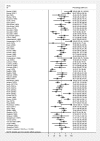Predictors of pain relief following spinal cord stimulation in chronic back and leg pain and failed back surgery syndrome: a systematic review and meta-regression analysis
- PMID: 23834386
- PMCID: PMC4238825
- DOI: 10.1111/papr.12095
Predictors of pain relief following spinal cord stimulation in chronic back and leg pain and failed back surgery syndrome: a systematic review and meta-regression analysis
Abstract
We sought to assess the extent to which pain relief in chronic back and leg pain (CBLP) following spinal cord stimulation (SCS) is influenced by patient-related factors, including pain location, and technology factors. A number of electronic databases were searched with citation searching of included papers and recent systematic reviews. All study designs were included. The primary outcome was pain relief following SCS, we also sought pain score (pre- and post-SCS). Multiple predictive factors were examined: location of pain, history of back surgery, initial level of pain, litigation/worker's compensation, age, gender, duration of pain, duration of follow-up, publication year, continent of data collection, study design, quality score, method of SCS lead implant, and type of SCS lead. Between-study association in predictive factors and pain relief were assessed by meta-regression. Seventy-four studies (N = 3,025 patients with CBLP) met the inclusion criteria; 63 reported data to allow inclusion in a quantitative analysis. Evidence of substantial statistical heterogeneity (P < 0.0001) in level of pain relief following SCS was noted. The mean level of pain relief across studies was 58% (95% CI: 53% to 64%, random effects) at an average follow-up of 24 months. Multivariable meta-regression analysis showed no predictive patient or technology factors. SCS was effective in reducing pain irrespective of the location of CBLP. This review supports SCS as an effective pain relieving treatment for CBLP with predominant leg pain with or without a prior history of back surgery. Randomized controlled trials need to confirm the effectiveness and cost-effectiveness of SCS in the CLBP population with predominant low back pain.
Keywords: back pain; meta-regression analysis; outcomes; predictive factors; spinal cord stimulation; systematic review.
© 2013 The Authors Pain Practice Published by Wiley Periodicals, Inc. on behalf of World Institute of Pain.
Figures





References
-
- Kumar K, Taylor RS, Jacques L, et al. Spinal cord stimulation versus conventional medical management for neuropathic pain: a multicentre randomised controlled trial in patients with failed back surgery syndrome. ISRCTN 77527324. Pain. 2007;132:179–188. - PubMed
-
- North RB, Kidd DH, Farrokhi F, Piantadosi SA. Spinal cord stimulation versus repeated lumbosacral spine surgery for chronic pain: a randomized, controlled trial. Neurosurgery. 2005;56:98–106. - PubMed
-
- Eldabe S, Kumar K, Buchser E, Taylor RS. An analysis of the components of pain, function, and health-related quality of life in patients with failed back surgery syndrome treated with spinal cord stimulation or conventional medical management. Neuromodulation. 2010;13:201–209. - PubMed
-
- North RB, Kidd D, Shipley J, Taylor RS. Spinal cord stimulation versus reoperation for failed back surgery syndrome: a cost effectiveness and cost utility analysis based on a randomized, controlled trial. Neurosurgery. 2007;61:361–368. - PubMed
-
- Simpson EL, Duenas A, Holmes MW, Papaioannou D, Chilcott J. Spinal cord stimulation for chronic pain of neuropathic or ischaemic origin: systematic review and economic evaluation. Health Technol Assess. 2009;13:iii. ix–x, 1–154. - PubMed
Publication types
MeSH terms
LinkOut - more resources
Full Text Sources
Other Literature Sources
Medical
Miscellaneous

